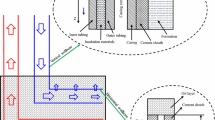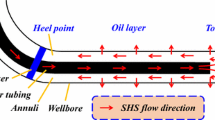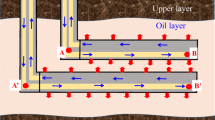Abstract
Steam-assisted-gravity-drainage (SAGD) is currently an effective technology for heavy oil recovery. The pre-heating stage is important to affect the overall process of SAGD development. In this paper, flow and heat transfer model in vertical well section and horizontal well section and thermal connectivity judgment model during cyclic pre-heating stage were established. Model calculation results are in good agreement with actual measurement results. The effects of steam injection rate and steam quality on the distribution of steam parameters along the whole wellbore and the distribution of heat transfer were compared. Besides, the optimization of steam injection parameter combination was provided. Ultimately, the effect of horizontal well spacing on pre-heating thermal connectivity was discussed. The results show that: With the increase of steam injection rate and steam injection quality, the pressure and temperature drop of the fluid increase. Wellhead required steam injection pressure and temperature increases and even superheated steam appear with the increase of steam injection rate and steam injection quality. The position where the pre-heating backflow turns from wet steam to subcooled water gradually shifts to the wellhead. With the increase of steam injection rate and steam injection quality, the heat transfer between annulus and reservoir decreases, but the uniformity of pre-heating in the horizontal section increases. The time required for cyclic pre-heating to form thermal communication between double wells increases significantly as the horizontal well spacing increases. To simultaneously integrate the uniformity and economy of pre-heating on the oilfield site, the steam injection quality at the heel end of the horizontal section of 0.7, the steam injection rate of 80 t/d, and the horizontal well spacing of 5 m were recommended.














Similar content being viewed by others
Abbreviations
- a :
-
Oil reservoir thermal diffusivity, m2/s
- a 1 :
-
Equivalent thermal diffusivity of oil reservoirs adjacent to the injection well, m2/s
- a 2 :
-
Equivalent thermal diffusivity of oil reservoirs adjacent to the production well, m2/s
- c p :
-
Specific heat at constant pressure, J/(kg·K)
- h an :
-
Specific enthalpies of annular reflux flow, J/kg
- h t :
-
Specific enthalpies of long tubing, J/kg
- h t1 :
-
Specific enthalpies of steam in injection pipe, J/kg
- h t2 :
-
Specific enthalpies of steam in production pipe, J/kg
- h s′:
-
Specific enthalpy of saturated water, J/kg
- h s″:
-
Specific enthalpy of the dry saturated steam, J/kg
- h sup :
-
Specific enthalpy of the superheated steam, J/kg
- i s :
-
Steam mass flow, kg/s
- p :
-
Fluid pressure, Pa
- q :
-
Radial heat flux density per unit length passing through this point, W/m
- r w1 :
-
Outer radius of the injection string, m
- r w2 :
-
Outer radius of the production string, m
- dW :
-
Work done by the friction force on the dz length, W
- ΔT s1 :
-
Temperature change value of the outer surface of the injection string, K
- ΔT s2 :
-
Temperature change value of the outer surface of the production string, K
- υ :
-
Fluid velocity, m/s
- υ an :
-
Average fluid velocity in annulus, m/s
- υ t :
-
Average fluid velocity in long tubing, m/s
- υ t1 :
-
Fluid average velocity in injection pipe, m/s
- υ t2 :
-
Fluid average velocity in production pipe, m/s
- x :
-
Steam quality of moist steam, dimensionless
- v :
-
Specific volume of single-phase flow, m3/kg
- θ :
-
Angle between pipe string axis and horizontal direction, rad
- τ :
-
Pre-heating time, d
- τ″:
-
Time conversion factor, takes the value of 86400
- λ 0 :
-
Oil reservoir thermal conductivity, W/(m·K)
References
Meyer RF, Attansi ED, Freeman PA (2007) Heavy oil and natural bitumen resources in geologic basins of the world. USGS open file report 2007 e1084
Babadagli T (2019) Technology Focus Heavy Oil. SPE-4007-PA 71:68–68
Sena M, Rosa L, Szklo A (2013) Will Venezuelan extra-heavy oil be a significant source of petroleum in the next decades? Energy Policy 61:51–59. https://doi.org/10.1016/j.enpol.2013.05.101
Khalil M, Lee RL, Liu N (2015) Hematite nanoparticles in aquathermolysis: A desulfurization study of thiophene. Fuel 145:214–220. https://doi.org/10.1016/j.fuel.2014.12.047
Butler RM, Mcnab GS, Lo HY (2010) Theoretical studies on the gravity drainage of heavy oil during in-situ steam heating. Can J Chem Eng 59:455–460
Ashrafi O, Navarri P, Hughes R, Lu D (2016) Heat recovery optimization in a steam-assisted gravity drainage (SAGD) plant. Energy 111:981–990. https://doi.org/10.1016/j.energy.2016.06.006
Zhang Z, Liu H, Dong X, Qi P (2017) Unified model of heat transfer in the multiphase flow in Steam Assisted Gravity Drainage process. J Pet Sci Eng 157:875–883. https://doi.org/10.1016/j.petrol.2017.08.001
Sivaramkrishnan K, Huang B, Jana AK (2015) Predicting wellbore dynamics in a steam-assisted gravity drainage system: Numeric and semi-analytic model, and validation. Appl Therm Eng 91:679–686. https://doi.org/10.1016/j.applthermaleng.2015.08.041
Yang J, Wang S, Lin R, Han F, Wang X, Guo B, Wang Z, Yang Z (2020) Simulation and scheme optimization of using superheated steam for huff and puff for preheating in SAGD. J China Univ Petrol Ed Nat Sci 44:105–113
Sun F, Yao Y, Li G, Qu S, Li X (2019) Effect of Pressure and Temperature of Steam in Parallel Vertical Injection Wells on Productivity of a Horizontal Well During the SAGD Process: A Numerical Case StudySPE International Heavy Oil Conference and Exhibition.
Irani M (2019) Oil-Rate Prediction Model for the Ramp-Up Phase of a Steam-Assisted-Gravity-Drainage Process: Stability Approach. Spe J 24:1016–1036. https://doi.org/10.2118/195674-pa
Lin R, Qi S, Shen W, Yang J, Wang X, Wang H, Wang S, Shu Z (2018) Study on parameters of steam injection in SAGD circulating preheating section. J China Univ Petrol Ed Nat Sci 42:134–141
Pan J, You H, Pan Y, Wu D, Yu L, Wang X, Qiu X, Zhang M (2016) Application of optical sensing system in heavy oil recovery. Measurement 79:198–202. https://doi.org/10.1016/j.measurement.2015.09.047
Ming-Hai XU, Hua-Wen S, Liang G, Xian-Hang S, Tao SJJoTe, Technology (2018) Calculation of temperature field in SAGD preheating stage of double horizontal wells
Anderson M, David K (2012) SAGD Startup: Leaving the Heat in the Reservoir. Society of Petroleum Engineers - SPE Heavy Oil Conference Canada 2012:2. https://doi.org/10.2118/157918-MS
Yuan J-Y, McFarlane R (2009) Evaluation of Steam Circulation Strategies for SAGD Startup. J Can Petrol Technol 50:20–32. https://doi.org/10.2118/2009-014
Zhang J, Fan Y, Xu B, Yang B, Yuan Y, Yu Y (2016) Steam Circulation Strategies for SAGD Wells After Geomechanical Dilation Start-Up
Moini B, Edmunds N (2013) Quantifying Heat Requirements for SAGD Startup Phase: Steam Injection, Electrical Heating. J Can Pet Technol 52:89–94. https://doi.org/10.2118/165578-pa
Dong XH, Liu HQ, Zhang ZX, Wang CJ (2014) The flow and heat transfer characteristics of multi-thermal fluid in horizontal wellbore coupled with flow in heavy oil reservoirs. J Pet Sci Eng 122:56–68. https://doi.org/10.1016/j.petrol.2014.05.015
Li MZ, Chen HJ, Zhang YY, Li WW, Wang YP, Yu M (2015) A Coupled Reservoir/Wellbore Model to Simulate the Steam Injection Performance of Horizontal Wells. Energy Technol 3:535–542. https://doi.org/10.1002/ente.201402184
Sun FR, Yao YD, Li GZ, Liu WY (2019) A numerical model for wet steam circulating in horizontal wellbores during starting stage of the steam-assisted-gravity-drainage process. Heat Mass Transf 55:2209–2220. https://doi.org/10.1007/s00231-019-02564-7
Li P, Zhang Y, Sun X, Liu Y, Xie M, Wang Z, Chen H (2019) Numerical simulation of influence law of steam injection parameters in SAGD preheating stage. J Central South Univ Sci Technol 50:2896–2905
Yang LQ, Wang HY, Gao YR (2013). Pre-Heating Circulation Design for Dual Horizontal Well SAGD in the Medium-Deep Extra Heavy Oil Reservoirs. https://doi.org/10.2523/16437-MS
Hight M, Redus C, Lehrmann J (1992) Evaluation of Dual-Injection Methods for Multiple-Zone Steamflooding. SPE Reserv Eng 7:45–51. https://doi.org/10.2118/18811-PA
Wang MK (1999) Quantitative calculation of wellbore heat transmission for steam injection wells. J Univ Petrol China (Edition of Nat Sci) 18:77–82
Best DA, Lesage RP, Arthur JE (1990) Steam Circulation in Horizontal Wellbores
Gu H, Cheng LS, Huang SJ, Du BJ, Hu CH (2014) Prediction of thermophysical properties of saturated steam and wellbore heat losses in concentric dual-tubing steam injection wells. Energy 75:419–429. https://doi.org/10.1016/j.energy.2014.07.091
Tiyao Z, Linsong C, Chunbai H, Pang Z, Fengjun Z (2010) Calculation model of on-way parameters and heating radius in a superheated steam injection wellbore. Pet Explor Dev 37:83–88. https://doi.org/10.1016/S1876-3804(10)60016-X
Duong A (2008) Thermal Transient Analysis Applied to Horizontal Wells1. https://doi.org/10.2118/117435-MS
Xi CF, Ma DS, Li XL (2010) Study on SAGD tecnology for ultra heavy oil in dual horizontal wells 32:103–108. https://doi.org/10.3863/j.issn.1674-5086.2010.04.019
Acknowledgements
This work was supported by the National Natural Science Foundation of China (No. 51874333), National Science and Technology Major Project of the Ministry of Science and Technology of China (No. 2016ZX05012-002). In addition, we thank Dr. Chang Lu for her linguistic assistance during the preparation of this manuscript.
Author information
Authors and Affiliations
Corresponding author
Additional information
Publisher's Note
Springer Nature remains neutral with regard to jurisdictional claims in published maps and institutional affiliations.
Appendices
Appendix A. dυ/dz for fog two-phase flow
The gas volume flow is much greater than the liquid volume flow in the mist flow state, thus the ideal gas equation can be applied in fog flow:
where Ts is saturation temperature of wet steam, K; ps is saturation pressure of wet steam, MPa.
For fog two-phase flow, dv/dz can be expressed as:
where υ is two-phase fluid velocity, m/s; ρ is two-phase fluid density, kg/m3; T is wet steam temperature, K; p is wet steam pressure, Pa.
Appendix B. Annulus characteristic length
The annulus characteristic length can be expressed as:
where do is the annulus characteristic length, m; dsi is the inner diameter of screen tube, m; dto is the outer diameter of long tubing, m.
Appendix C. Flow friction coefficient
The frictional work between the steam and the pipe wall can be expressed as:
where υ[i], υ[i + 1] are the average velocities of the section located at the i and i + 1 nodes respectively, m/s.
f ' is friction coefficient between fluid and pipe wall, dimensionless:
where Res is Reynolds number of single-phase flow, dimensionless; ∆ is the relative roughness of pipe wall, dimensionless.
Steam is injected from point A of the long tubing, dissipating heat to the oil reservoir along the way, and may be converted into subcooled water in the annulus. If the steam transforms into supercooled water during the flow, the pipe wall friction coefficient is related to the casing wall roughness, the Reynolds number and the flow pattern of the fluid. The calculation formula of the single-phase pipe flow friction coefficient can be found in the literature [1]. If it is a two-phase flow in the flow process, the density and resistance coefficient of two-phase flow are calculated by B-B method [2]. The calculation of other physical parameters of two-phase flow and single-phase flow can refer to the Witney given method [3]. The calculation of forced convection heat transfer coefficient of two-phase flow and single-phase flow can refers to the Akers given method [4].
Appendix D. Heat exchange in the vertical wellbore
The double-tube structure wellbore section is shown in Fig. 15.
The heat dissipation of injection pipe per unit length can be expressed as:
The calculation of the radiation heat of the production pipe refers to the above method and the heat dissipation of the production pipe per unit length is as follows:
The natural convection heat exchange between the outer wall of the injection pipe and the annulus per unit length dQt1c/dz in Eq. (28) can be expressed as:
where rt1 is the outer radius of the injection pipe, m; Tan is the average annulus temperature, K; T1 is the steam temperature in the injection pipe, K; \(\lambda\) is the thermal conductivity of the annulus, W/(m·K).
The radiation heat exchange of injection pipe surface to production pipe surface per unit length dQ12r/dz in Eq. (28) can be expressed as:
where T2 is the steam temperature in production pipe, K; rt2 is the outer radius of production pipe, m; σ is the Stefan-Boltzmann constant, 5.67 × 10–8 W/(m2·K4); εt1 is the radiation coefficient of outer surface in injection pipe, dimensionless; εt2 is the radiation coefficient of outer surface in production pipe, dimensionless; a is the half of the radiation angle of the injection string to the production string, rad; The relationship between a and β is shown in Fig. 15.
The radiation heat exchange of injection pipe surface to the inner wall of casing s per unit length dQ1cir/dz in Eq. (28) can be expressed as follows:
where Tci is the temperature of the casing inner wall, K; rci is the inner radius of casing, m; εci is the radiation coefficient of the casing inner surface, dimensionless;
The temperature of casing inner wall can be expressed as:
f(t) can be calculated by Chiu formula [5]:
where To is the temperature of the oil layer, K; λo is the formation thermal conductivity, W/(m·K); a is oil reservoir thermal diffusivity, m2/s; Th is the temperature at the outer edge of cement ring, K.
where λc is the thermal conductivity of casing, W/(m·K); λcem is the thermal conductivity of cement ring, W/(m·K); dci, dco are the inner diameter and outer diameter of casing respectively, m; dcemi, dcemo are the inner diameter and outer diameter of cement ring respectively, m;
According to Ramey’s approximate solution, the radial heat flux density at the interface between the outer edge of the cement ring and the formation:
Heat exchange from casing inner wall to the outer edge of cement ring:
Appendix E. Heat exchange in the horizontal wellbore
Heat exchange between the steam in the long tubing and backflow in the annulus can be expressed as:
where Tt, Tan are the fluid temperature of long tubing and annulus respectively, K; hti, hto are the forced convection heat transfer coefficients of the inner wall and the outer wall in the long tubing respectively, W/(m2·K); λt is the thermal conductivity of long tubing, W/(m·K).
Heat exchange between the backflow in the annulus and the outer edge of the screen tube:
where Tso is the temperature of the screen tube outer edge, K; han is the forced convective heat transfer coefficient of the inner wall of the annulus, W/(m2·K); λs is the thermal conductivity of screen tube, W/(m·K); dso is the outer diameter of screen tube, m.
According to Ramey's approximate solution, the radial heat flux density at the interface between the screen and the oil layer:
The temperature of the screen tube outer edge:
Rights and permissions
About this article
Cite this article
Wang, Q., Yang, Z., Qi, S. et al. Simultaneously modelling steam flow and heat transfer in vertical and horizontal wellbores during SAGD cyclic pre-heating stage. Heat Mass Transfer 58, 949–965 (2022). https://doi.org/10.1007/s00231-021-03148-0
Received:
Accepted:
Published:
Issue Date:
DOI: https://doi.org/10.1007/s00231-021-03148-0





